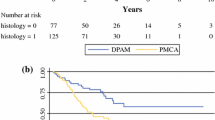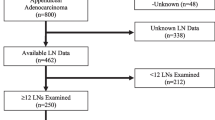Abstract
Background
Long-term survival of patients with appendiceal or colorectal peritoneal carcinomatosis (PC) may be achieved by combining cytoreductive surgery with hyperthermic intraperitoneal chemotherapy (CRS/HIPEC). Unfortunately, such favorable outcomes are realized in a minority of patients. Given the morbidity of the CRS/HIPEC and the uncertain role of postresection systemic therapy, it is important that prognostic factors in high-grade PC be clearly defined.
Methods
This single center, retrospective, cohort study examined the outcomes of CRS/HIPEC performed on patients with high-grade PC secondary to appendiceal or colorectal adenocarcinoma between 2007 and 2013. Cox regression analysis was utilized to evaluate the association between potential prognostic factors [age, sex, primary site, lymph node (LN) status, peritoneal cancer index (PCI) score, completeness of cytoreduction score (CC score), number of visceral resections, and systemic chemotherapy] and progression-free survival (PFS).
Results
A total of 70 patients with high-grade appendiceal or colorectal PC underwent CRS/HIPEC during the study period; 82.9 % underwent complete (CC-0) cytoreduction with a median PFS of 9.7 months. Positive LNs at the time of CRS/HIPEC were predictors of worse PFS on univariate and multivariate analysis. No association was demonstrated between pre- or post-HIPEC systemic chemotherapy and PFS.
Conclusions
High-grade PC secondary to appendiceal or colorectal adenocarcinoma can be managed with CRS/HIPEC. The number of LN metastases at the time of CRS/HIPEC is the strongest predictor of progression and must be considered when determining patient eligibility for this aggressive treatment.

Similar content being viewed by others
References
Sugarbaker PH. Patient selection and treatment of peritoneal carcinomatosis from colorectal and appendiceal cancer. World J Surg. 1995;19(2):235–40.
Verwaal VJ, van Ruth S, de Bree E, et al. Randomized trial of cytoreduction and hyperthermic intraperitoneal chemotherapy versus systemic chemotherapy and palliative surgery in patients with peritoneal carcinomatosis of colorectal cancer. J Clin Oncol. 2003;21(20):3737–43.
Glehen O, Mohamed F, Gilly FN. Peritoneal carcinomatosis from digestive tract cancer: new management by cytoreductive surgery and intraperitoneal chemohyperthermia. Lancet Oncol. 2004;5(4):219–28.
Glehen O, Kwiatkowski F, Sugarbaker PH, et al. Cytoreductive surgery combined with perioperative intraperitoneal chemotherapy for the management of peritoneal carcinomatosis from colorectal cancer: a multi-institutional study. J Clin Oncol. 2004;22(16):3284–92.
Chua TC, Moran BJ, Sugarbaker PH, et al. Early- and long-term outcome data of patients with pseudomyxoma peritonei from appendiceal origin treated by a strategy of cytoreductive surgery and hyperthermic intraperitoneal chemotherapy. J Clin Oncol. 2012;30(20):2449–56.
Brucher BL, Piso P, Verwaal V, et al. Peritoneal carcinomatosis: cytoreductive surgery and HIPEC—overview and basics. Cancer Invest. 2012;30(3):209–24.
Bruin SC, Verwaal VJ, Vincent A, van’t Veer LJ, van Velthuysen ML. A clinicopathologic analysis of peritoneal metastases of colorectal and appendiceal origin. Ann Surg Oncol. 2010;17(9):2330–40.
Portilla AG, Shigeki K, Dario B, Marcello D. The intraoperative staging systems in the management of peritoneal surface malignancy. J Surg Oncol. 2008;98(4):228–31.
Levine EA, Stewart JH, Shen P, Russell GB, Loggie BL, Votanopoulos KI. Intraperitoneal chemotherapy for peritoneal surface malignancy: experience with 1,000 patients. J Am Coll Surg. 2014;218(4):573–85.
Esquivel J, Farinetti A, Sugarbaker PH. Elective surgery in recurrent colon cancer with peritoneal seeding: when to and when not to proceed. Il G Chir. 1999;20(3):81–6.
Clavien PA, Barkun J, de Oliveira ML, et al. The Clavien–Dindo classification of surgical complications: five-year experience. Ann Surg. 2009;250(2):187–96.
Glehen O, Gilly FN, Boutitie F, et al. Toward curative treatment of peritoneal carcinomatosis from nonovarian origin by cytoreductive surgery combined with perioperative intraperitoneal chemotherapy: a multi-institutional study of 1,290 patients. Cancer. 2010;116(24):5608–18.
Kuijpers AM, Mirck B, Aalbers AG, et al. Cytoreduction and HIPEC in the Netherlands: nationwide long-term outcome following the Dutch protocol. Ann Surg Oncol. 2013;20(13):4224–30.
Winer J, Zenati M, Ramalingam L, et al. Impact of aggressive histology and location of primary tumor on the efficacy of surgical therapy for peritoneal carcinomatosis of colorectal origin. Ann Surg Oncol. 2014;21(5):1456–62.
Franko J, Shi Q, Goldman CD, et al. Treatment of colorectal peritoneal carcinomatosis with systemic chemotherapy: a pooled analysis of north central cancer treatment group phase III trials N9741 and N9841. J Clin Oncol. 2012;30(3):263–7.
Van der Speeten K, Stuart OA, Sugarbaker PH. Pharmacokinetics and pharmacodynamics of perioperative cancer chemotherapy in peritoneal surface malignancy. Cancer J. 2009;15(3):216–24.
Park JS, Choi GS, Hasegawa S, et al. Validation of the seventh edition of the American Joint Committee on cancer tumor node-staging system in patients with colorectal carcinoma in comparison with sixth classification. J Surg Oncol. 2012;106(6):674–9.
Elias D, Gilly F, Boutitie F, et al. Peritoneal colorectal carcinomatosis treated with surgery and perioperative intraperitoneal chemotherapy: retrospective analysis of 523 patients from a multicentric French study. J Clin Oncol. 2010;28(1):63–8.
El Halabi H, Gushchin V, Francis J, et al. Prognostic significance of lymph node metastases in patients with high-grade appendiceal cancer. Ann Surg Oncol. 2012;19(1):122–5.
Kuijpers A, Mehta A, Boot H, et al. Perioperative systemic chemotherapy in peritoneal carcinomatosis of lymph node positive colorectal cancer treated with cytoreductive surgery and hyperthermic intraperitoneal chemotherapy. Ann Oncol. 2014;25(4):864–9.
Acknowledgment
The authors thank the contributions of Debbie Soldano for her generous assistance and time with patient follow-up as well as our patients who have contributed to this study.
Disclosures
None.
Author information
Authors and Affiliations
Corresponding author
Rights and permissions
About this article
Cite this article
Baumgartner, J.M., Tobin, L., Heavey, S.F. et al. Predictors of Progression in High-Grade Appendiceal or Colorectal Peritoneal Carcinomatosis After Cytoreductive Surgery and Hyperthermic Intraperitoneal Chemotherapy. Ann Surg Oncol 22, 1716–1721 (2015). https://doi.org/10.1245/s10434-014-3985-y
Received:
Published:
Issue Date:
DOI: https://doi.org/10.1245/s10434-014-3985-y




